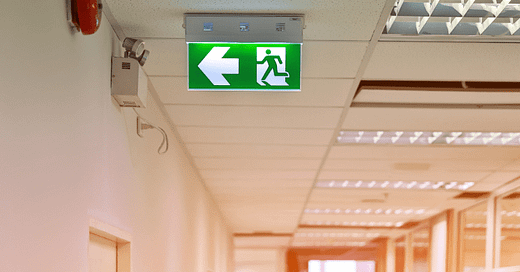mergency Preparedness : The Drill You Can't Afford to Skip 🚨
Why Practicing Your Escape Plan Regularly Could Save Lives—and Your Business
When was the last time you practiced your emergency escape plan ?
If you have trouble remembering, maybe it's time to rethink your approach to safety training.
In logistics, manufacturing, warehousing and any other industry where goods are moved or people are managed, preparing for emergencies is not an option, it’s a must.
Emergencies don’t wait for ideal conditions, they occur when you least expect them and every second counts.
Why Simulating Fire Scenarios is More Than Just a Drill
Conducting fire drills and emergency simulations isn’t just about ticking a box for compliance, It’s about creating a real, actionable plan that ensures swift and safe evacuations in moments of chaos.
Here’s why you should prioritize these exercises:
→ Validate Your Plans
Having a plan on paper is a start, but real-world testing is what truly validates it.
Live simulations expose weaknesses that might not be obvious in theory.
Adjustments and improvements become clear only when the plan is put into practice.
→ Develop Staff Competencies
Emergency training builds confidence and muscle memory.
When your team knows their roles by heart, they can act decisively under pressure, rather than freezing in critical moments.
Well-prepared staff not only protect themselves but also contribute to the overall safety of the entire operation.
→ Test Established Procedures
Regular drills ensure that emergency procedures stay fresh and familiar.
In high-stress environments, even the best-documented plans can fail if they’re not practiced consistently.
Frequent testing reinforces readiness, transforming protocols from written instructions into instinctive actions.
The Real Cost of Not Being Prepared
Neglecting regular training can lead to confusion, slower evacuations, and ultimately, greater harm during an actual emergency.
Beyond physical safety, an unprepared response can expose businesses to major operational, legal, and reputational risks.
In industries where supply chains are complex and operations are critical, a single emergency mishandled can lead to cascading disruptions that affect not just one facility, but entire networks of partners, suppliers, and customers.
Building a Culture of Readiness
A strong safety culture doesn’t happen by accident—it’s built through consistent practice, leadership commitment, and the belief that preparedness protects lives and livelihoods.
Whether you oversee a warehouse, a logistics hub, a corporate office, or a manufacturing plant, regular emergency drills must be a fundamental part of your operational excellence.
So, How Often Should You Conduct These Training Sessions ?
At minimum, twice a year is a common best practice. But depending on the complexity of your operations, your workforce turnover rate, and your specific risks, quarterly drills may be more appropriate.
The key is consistency, the more realistic and routine the training, the better your team's chances of performing effectively when it matters most.
Final Thought
Emergencies don’t come with a warning.
The time you invest today in preparing your team could be the difference between a crisis averted and a disaster realized tomorrow.
So, when was the last time you tested your emergency escape plan ?
How often do you conduct these vital training sessions ?
Let’s start the conversation—because safety isn’t just important, it’s non-negotiable.
Stay tuned to Logistics Insider for more insights on innovations shaping the world of Supply chain.
Follow Logistics Insider to get the latest supply chain and innovation news.





